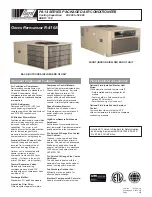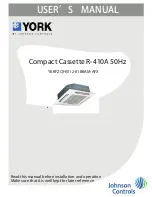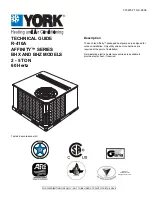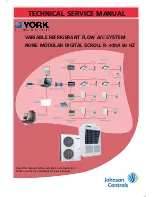
8
»
Aluminum tape or mastic
»
Miscellaneous hanging materials - field provided
NOTE:
Be sure to review ‘Rules for Safe Installation and
Operation’ on page 1 of this document before
start-up of this unit.
Forced Air Handler/Furnace System with an HRV/ERV
Forced air handler/furnace system with an HRV/ERV This
application provides filtration of all Outdoor Air (OA) that is
brought into the home through the HRV/ERV, thus reducing
the introduction of dust, pollen and mold from the outdoor
air. For systems that have HRV/ERV units installed, we
recommend ducting the ‘fresh air’ outlet from the HRV/ERV
into the HEPA system. If the HRV/ERV CFM (cubic feet
per minute) rating is lower than that of the HEPA system,
an additional return needs to be installed into the HEPA
system.
The output air from the HEPA system then needs to be
installed into the main return of the air handler/furnace
system.
Example of Return to Return Installation with HRV/
ERV
For homes with a forced air handler/furnace system and an
HRV/ERV system.
Additional Return
Air Handler / Furnace
Air Handler / Furnace Filter
HEPA System
HRV /
ERV
Figure 14. Typical Return to Return Application
(HRV/ERV)
NOTE:
This filtration system is an ADDITIONAL filter, and
does NOT replace the existing air handler/furnace
system filter.
Preparation
Here are some things to consider as you decide where to
install the HEPA system with an HRV/ERV.
1.
Location:
»
Make sure there is room to open the HEPA filter ac
-
cess panel for filter changes/inspections.
»
Keep the HEPA system in a location where you can
still access the air handler/furnace filter.
»
Keep the HEPA system away from possible water
damage
»
Vibration pads will reduce vibration for installations
where the unit is placed on the floor.
»
Install HEPA System on floor or suspended platform.
If the unit is suspended, screws must not penetrate
through the cabinet. Make sure that you have the
proper chains/straps/joists and equipment to keep
unit secure.
2.
Inlet (Marked as ‘Air In’ on unit):
»
Most HRV/ERV systems will not move as much air
as the HEPA system. For these systems, install an
additional return from another treated air source into
the HEPA system.
»
If using an additional return duct, it should be in-
stalled upstream of any humidifiers. The fresh air
outlet of the HRV/ERV should be “Y” connected to
the additional return duct then connected to the inlet
of the HEPA system.
»
The additional return duct (if any) should be installed
at least 8 ft. away from the outlet duct on the main
return.
»
Duct both the HRV/ERV and the additional return
into the inlet of the HEPA system.
3.
Outlet (Marked as ‘Clean Air Out’ on unit):
»
Outlet duct should be installed as close to the air
handler/furnace inlet as possible but not directly into
the return air elbow of the main return.
»
To reduce static pressure, install outlet with a 45 de-
gree takeoff directly up-line from the return air elbow
of air handler/furnace.
4.
Ducting
»
If HEPA system is installed where inlet and outlet
collars face down, metal elbows must be connected
to both inlet and outlet collars.
»
Each connection must be sealed with aluminum
tape or mastic, including all take offs.
»
Installed duct runs should be as straight as possi-
ble (if the duct runs are too long, reduced CFM may
result).
»
If duct is exposed to unconditioned air, externally in-
sulated flex duct is highly recommended.
»
Externally insulated flex duct can also be used for
noise reduction purposes
»
For best indoor air quality, do not use duct-board or
fiberglass inside of ducts.
5.
Electricity
The unit must be plugged into a grounded 120V, 60Hz out-
let.
Required Materials for Installation of Unit:
1.
For Model: HEPA-20
»
8” diameter flex or rigid duct (as required)
»
6” diameter flex or rigid duct (as required)
»
6” diameter 45 degree takeoff
»
Aluminum tape or mastic
»
Miscellaneous hanging materials - field provided
2.
For Models: HEPA-40 and HEPA-60
»
10” diameter flex or rigid duct (as required)
»
8” diameter flex or rigid duct (as required)




























